Hey, good news! I finally have a place to put my feet up in the beach house living room. Or, as Sherry would state this good news: we finally have a coffee table!
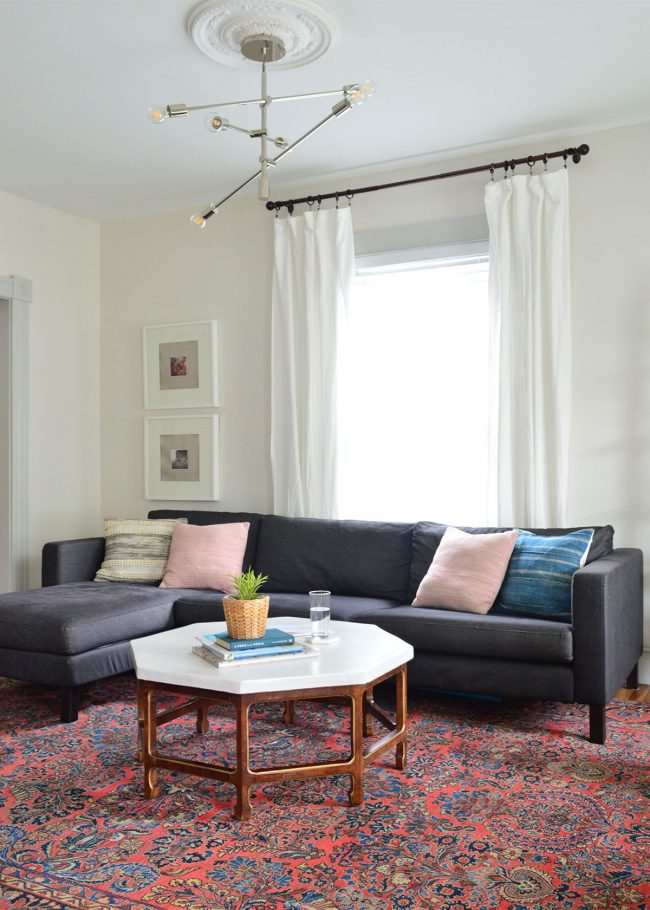
light fixture / ceiling medallion / similar rug / similar sofa / similar curtains / curtain rods
And it was a DIY that was SO MUCH CHEAPER than the high end alternative, so three cheers for that. Oh and people who follow our InstaStories know we’ve switched out the rug in here for this rug since taking these pics, so there will be a post all about that (and the other dining room tweak we’ve made) coming up in a week or two. But back to the coffee table.
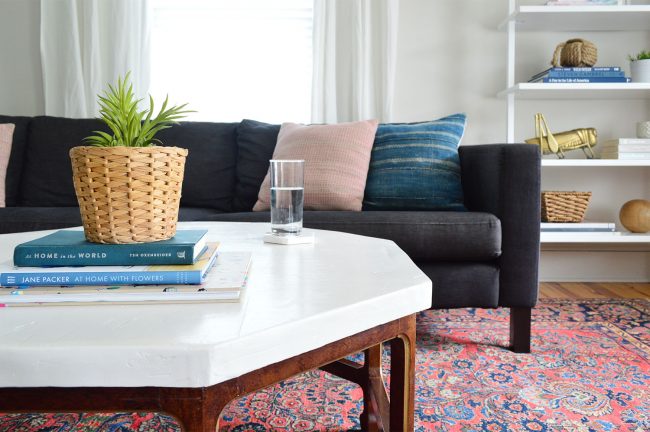
We’ve actually had the table base for a while, but it’s been completely topless for months. We scored this wooden octagonal table base from a neighbor who had planned on adding a top to it at some point, but after months of doing nothing with it she put it on our neighborhood buy/sell board for a whopping $7. After paying 700 pretty pennies for it, it remained topless in our garage for several months before moving to the beach house last fall (see below)… where it remained – still topless – until last month.
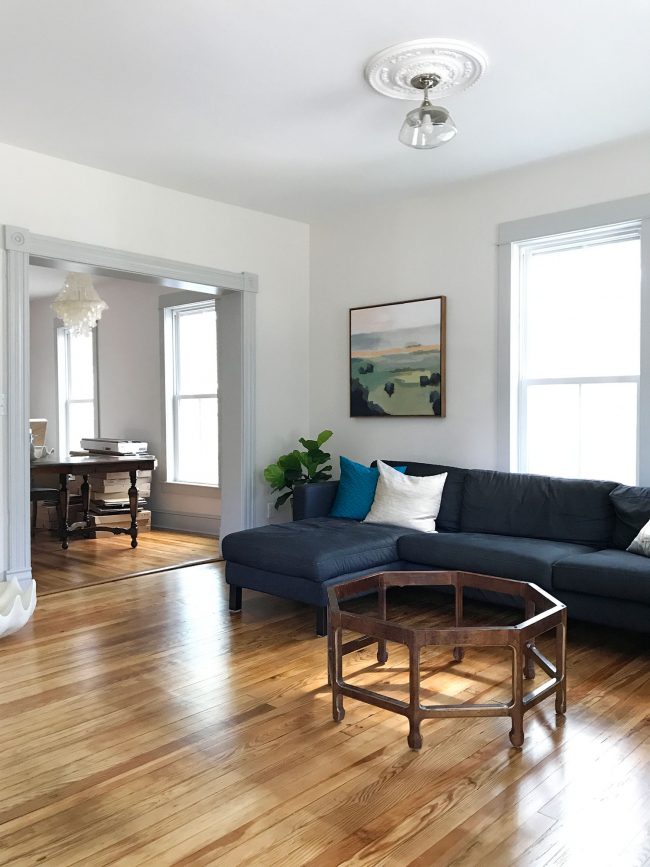
Our grand scheme was to get a stone top custom cut for it. Marble would look great, but we also considered more durable options like quartz. But quotes from two different stone yards – even for remnant pieces – came back between $700 – $900. I KNOW. They were MUCH higher than we expected, partially because of the size (it’s 38″ at its widest, which makes it deeper than a standard countertop by a fair amount) and the octagonal shape.
So we quickly shifted from “buying a stone top for it” to “DIYing a stone-like top for it” – and after weighing all sorts of solutions (faux stone laminate, a wood top we painted white or even tried to “marble”, etc) we landed a white concrete top that would give us a nice chunky stone look, but at a much cheaper cost. Unfortunately, the project kept getting nudged behind bigger tasks like installing the kitchen and building bunk beds. Hence why I was forced to uncomfortably prop my feet up on this edge of this puppy each time we visited. Feel bad for me, please.
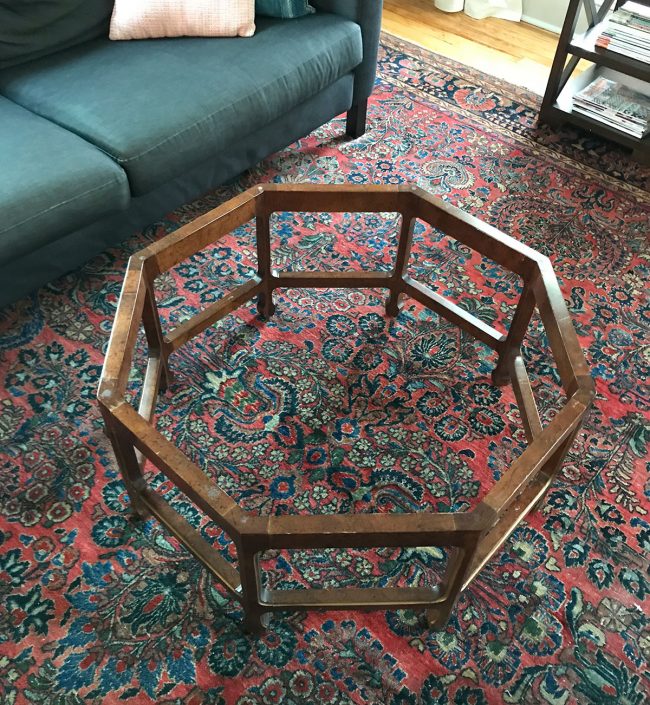
We feared that a solid poured concrete slab would (a) be very heavy and (2) be very prone to cracking or breaking – especially without adding lots of extra support under the table top. Plus little kid heads + a solid hunk of concrete sounded worrisome. So instead we decided to create a wood top and then cover the wood with Ardex Feather Finish, which is a thin concrete material that we used years ago to give our laminate kitchen counters the appearance of solid concrete.
Making The Wood Coffee Table Top
We picked up a 4 x 4′ sheet of 3/4″ plywood because we wanted something sturdy enough to span the tabletop without sagging. To mark my cuts, I simply flipped the table over on top of the plywood and traced the edges with a pen. Don’t worry, I’ll show you how I made it overhang the table’s edge in a moment.
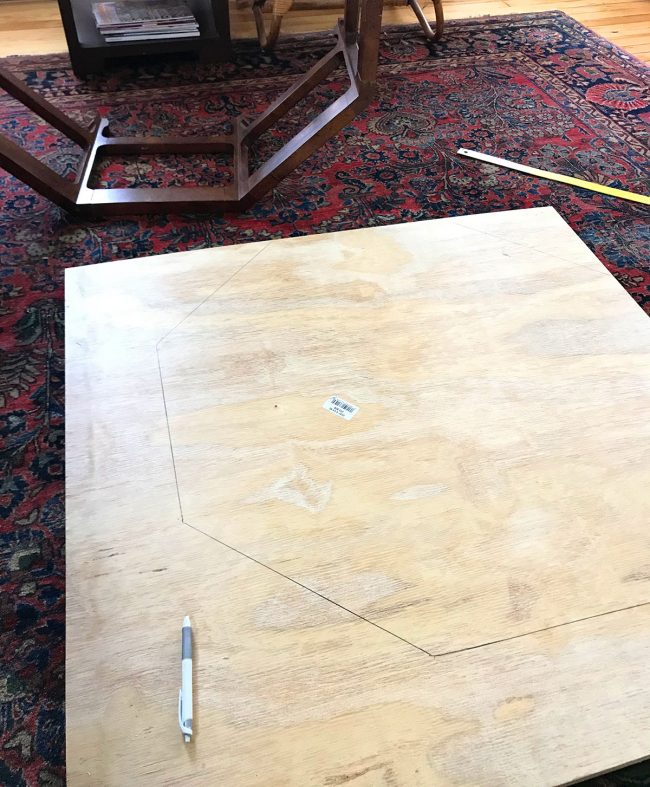
Using my circular saw outside, I trimmed off the edges to get an octagon that perfectly fit the top of our table base. No overhang. Yet.
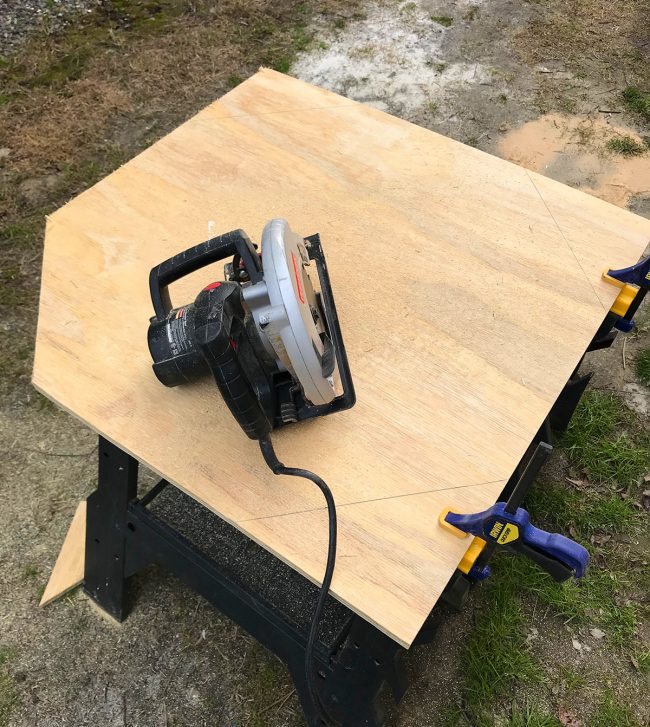
Next I cut 8 pieces of 1 x 2″ whitewood to create a border around my cut plywood. After summoning some of my 8th-grade geometry, I determined that I needed to cut each one at a 22.5-degree angle to fit them around the octagon. But surprise-surprise, my miter saw was one step ahead of me and already had that as a preset angle.
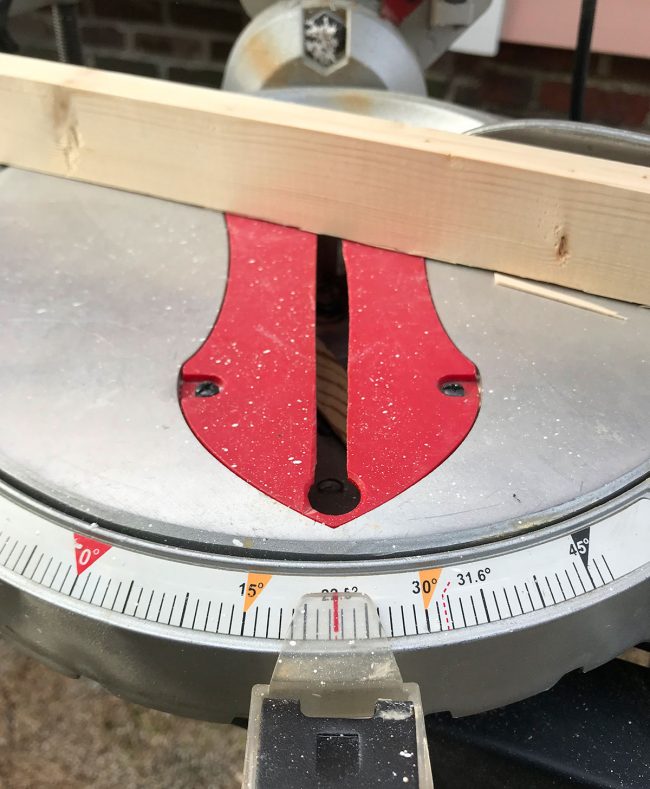
Then, with the plywood laid on top of the base with the edges flush, I started nailing each of my 1 x 2″ pieces around the edges (into the plywood, not the table base). I put wood glue on it before I nailed, which help things hold for the long haul. Adding this border did a few helpful things:
- It made the wood top slightly larger than the base, giving it a nice overhang
- It made the wood top look twice as thick as it really is, without adding much more weight to it
- It helped keep the top in place by making it almost like a snug shoebox top. I still screwed it to the base from underneath just to be safe.
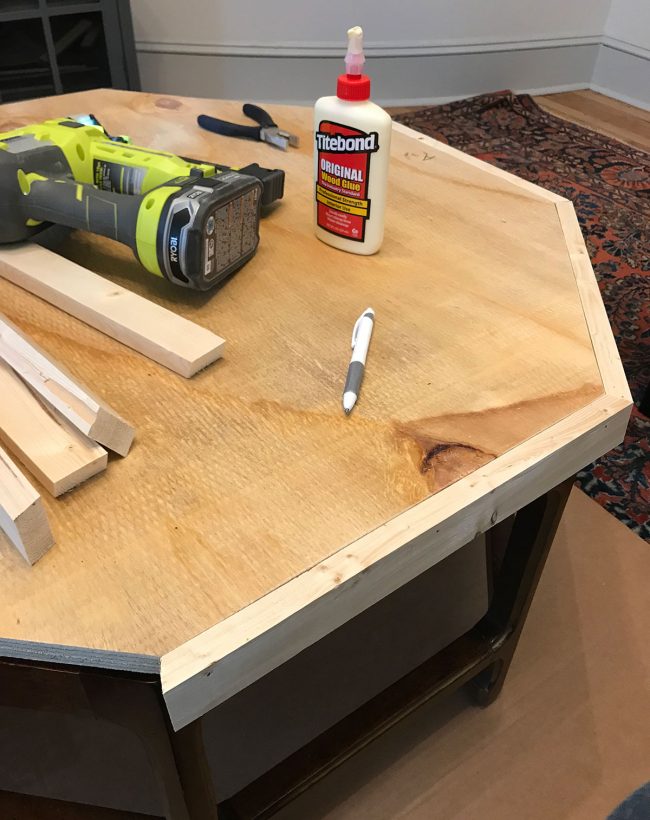
Once it was all nailed in, I used wood putty to fill in all of my gaps and nail holes. This probably wasn’t a super critical step (I was going to coat this with a skim coat of concrete, after all) but I discovered the table isn’t a perfect octagon, so some of my corners weren’t as tight as I’d hoped. This shot is from before I sanded the excess wood filler off:
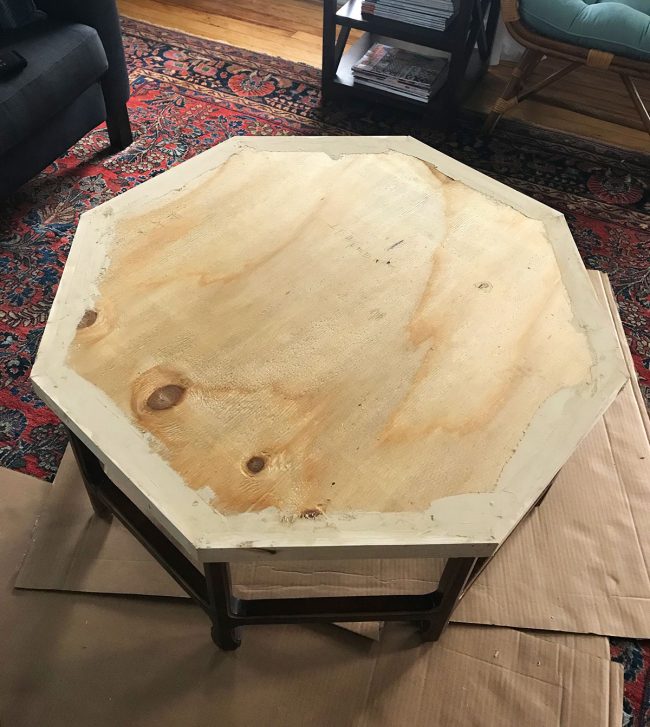
Applying The Concrete Finish
We haven’t used Ardex Feather Finish since our first project with it: our old kitchen’s laminate counters (here’s the tutorial for applying it and then sealing them to be food safe). While we decided the application was awesome for a quick makeover, they did get a little oil-stained around the stove since we used food-safe sealer as opposed to some of the more heavier duty sealers. No worries, we just added a cutting board to cover the small splatters – and we loved the imperfections and movement that was created in the application process. Definitely a whole lot better than the old plastic-y counters the house came with. Overall: we’d definitely recommend this method for a kitchen counter update – especially if you use a stronger sealer.
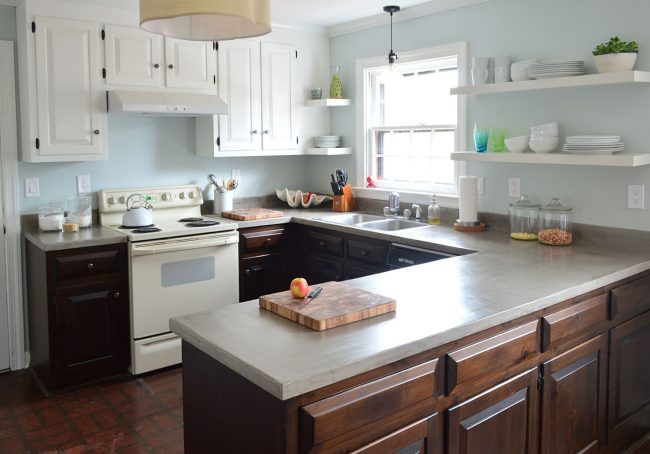
For the coffee table we decided to use the white Ardex instead of the standard gray color, so we tracked down a 10 pound bag online for $40. The dry Ardex mix just combines with water, so to apply it all you really need are some mixing/measuring buckets and various sized trowels to apply and smooth it. Oh, and sandpaper and a power sander (this is the one we have).
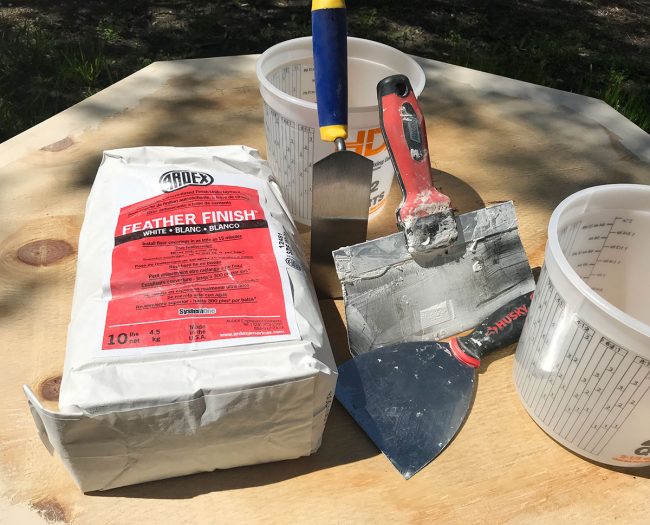
The bag suggested a 2 to 1 mix of Ardex powder to water, but I read our old post and reminded myself that I had liked a bit more water than that – it helped keep the mix looser and easier to spread. So I started by measuring one small batch at a time (I think I needed about twice this much to complete one coat).
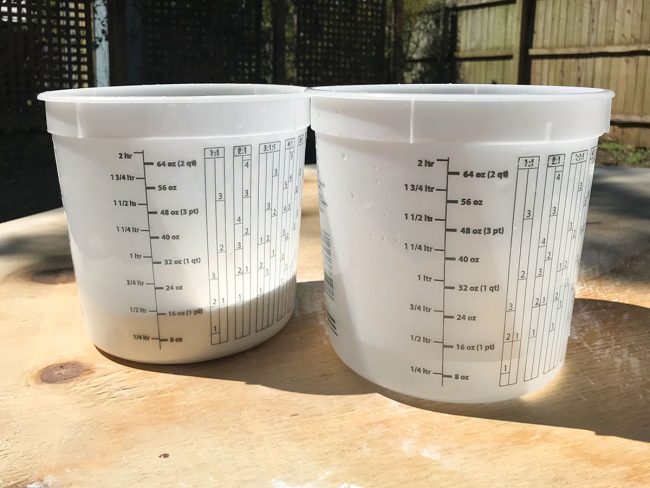
I mixed them together using a small trowel, making sure to getting any remaining powder mixed in. I aimed for a thick pancake batter consistency – like it would sorta hold to my trowel for a moment before dripping off on its own.
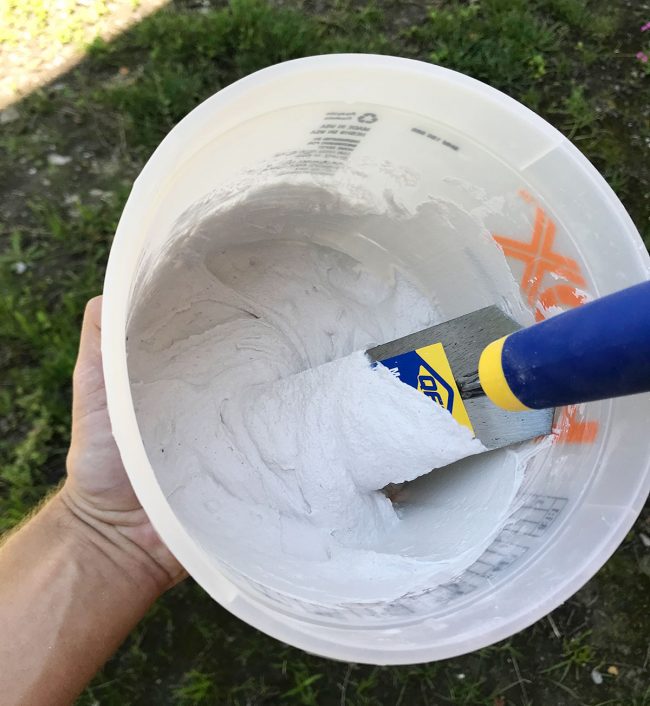
Then I just scooped everything onto my table and started spreading it smooth, using larger trowels on the top and smaller ones on the edges. Note: whatever surface you’re doing this on should be sanded enough to be rough. Our plywood was already slightly textured, so I could skip this step, but if you’re doing it on the top of a piece of furniture, be sure to take a pass with low-grit sandpaper first (like 60-80 grit).
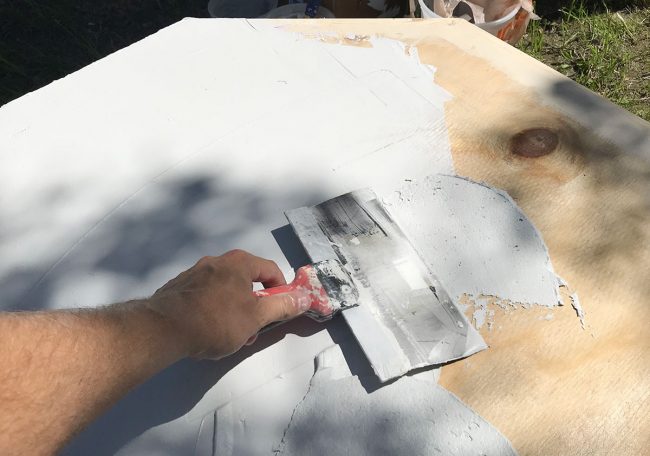
Ardex takes more than one coat (we did two this time) so my first pass was really about coverage, not smoothness. I was worried about sanding too much off during the next step, especially on the edges and corners, so I threw caution to the wind and really laid it on thick around the edge.
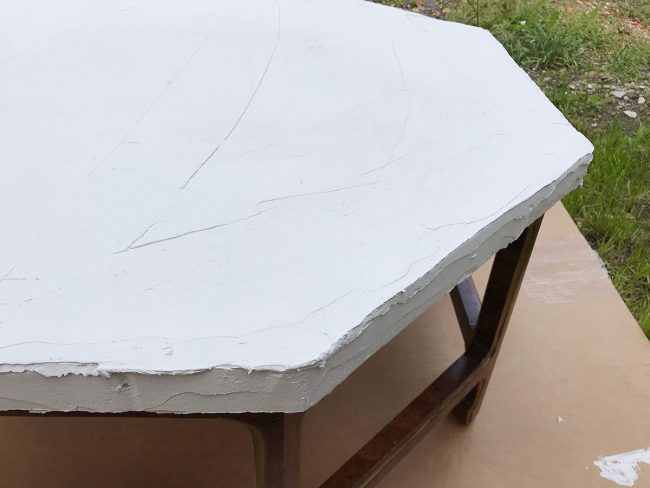
I gave it several hours to dry and then came back to start smoothing. The first thing I did (and my favorite part) was to use a putty knife to scrape all of the stalactites that dripped down the bottom edge. It was so satisfying and it gave us a really clean edge on the bottom.
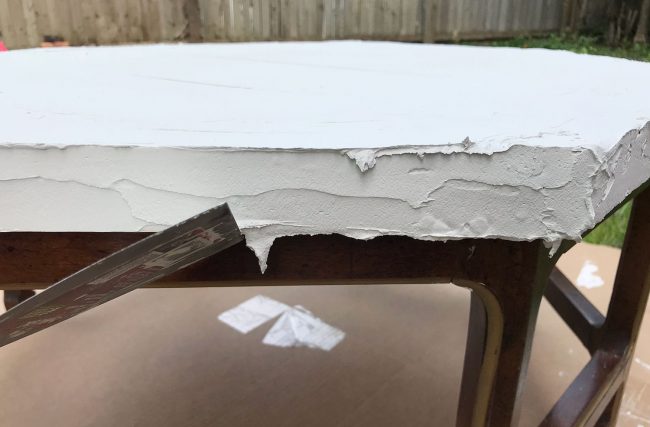
Then I took some low-grit sandpaper (80) and went to town on the rest of the top with my palm sander. Since I knew another coat was coming after this one, I wasn’t concerned about getting it flawlessly smooth. I mostly wanted to eliminate any hard ridges that would catch clumps of Ardex during my next application.
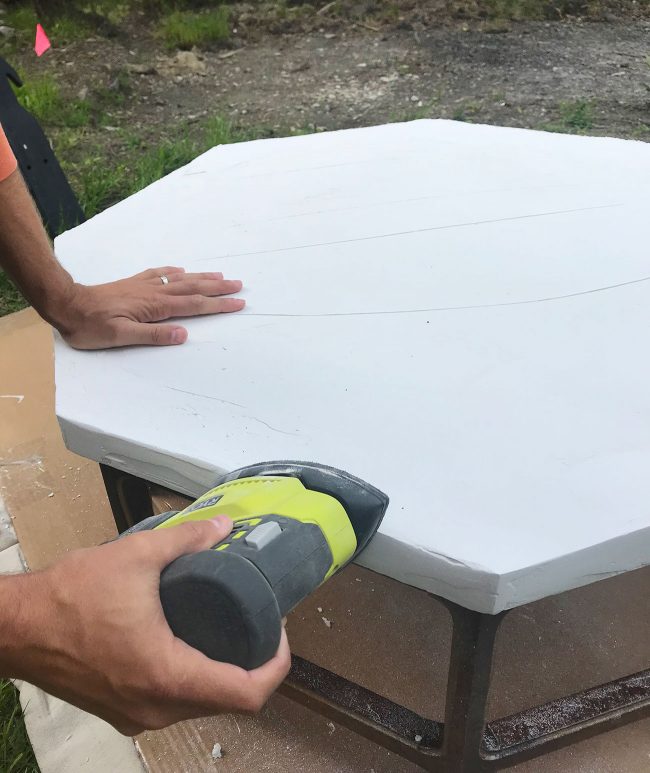
This is what the top looked like after I sanded the first coat. Obviously, you can see lots of my trowel marks as well as little pockets where the Ardex didn’t spread completely smoothly. It’s a bit rougher than we wanted for the final product, but it was fine for a first coat.
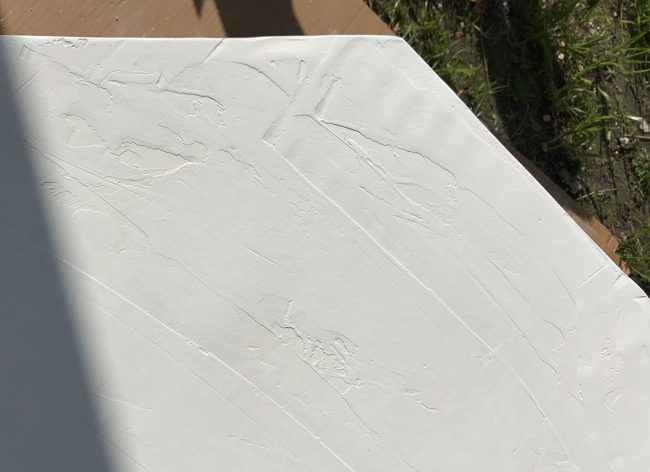
The second coat went on in pretty much the exact same method – except I did mix the Ardex a bit thinner and I took a bit more care getting a smoother application since this would be the top one that’s seen by everyone. Plus, when I sanded it, I moved from my initial low-grit (80) sandpaper down to 120 then 220, so that the finished table was super smooth. I didn’t remember to snap any photos of the coffee table after we sanded the second coat, but took lots of them once it was sealed and finished, so if we skip ahead for a second, here’s the finished result:

Sealing The Concrete
There are lots of products out there for sealing concrete. As I mentioned, we used food safe eco-sealer on our kitchen counters, which we think might be the reason tiny little grease spatters sunk in next to the stove – but since we’re not planning to prepare food on this table, we went with something heavier duty for a nice super-durable finish this time. Our final choice? This “Wet-Look” Sealer by Behr. Sherry suggested something high-gloss, which would really mimic that glossy stone look, and we were both really happy with how it turned out. Almost a mirror-like shine – which you can sort of see in the photo above.
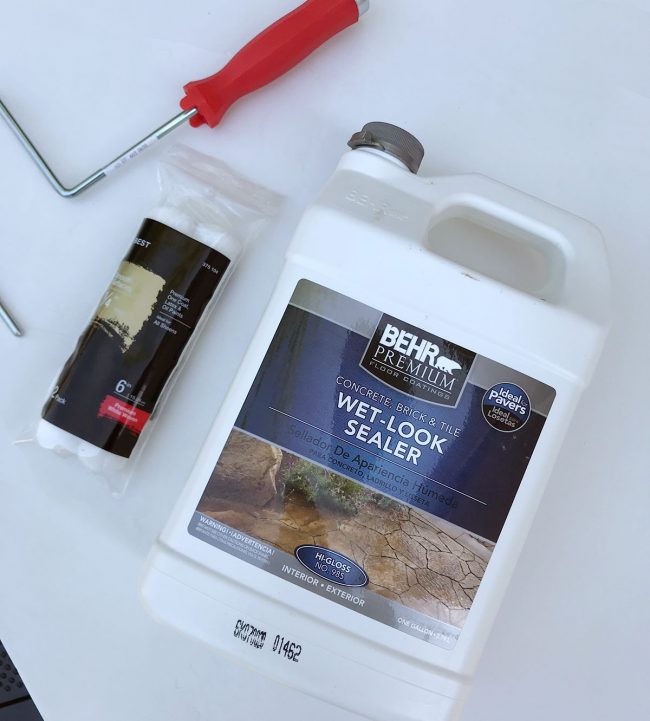
I just used a small foam roller to apply a thin coat along the top and all of the sides. Once it had dried for a few hours, we did a second coat (and later a third coat, just to be safe). I barely made a dent in the 1 gallon container (it was the smallest one they sold) but at least I have some on hand to do a touch-up sealing coat every year or two, just to be safe.
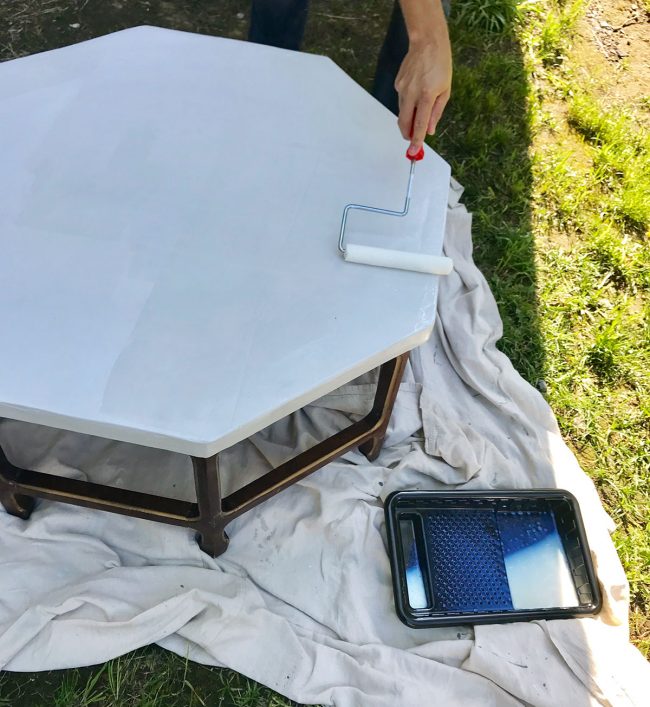
Once it was all fully dry, we brought it in and let it cure for a week before putting any objects on it (not that it needs that long – we just weren’t at the beach house for a week). And BOY DOES IT FEEL GOOD TO HAVE A COFFEE TABLE!
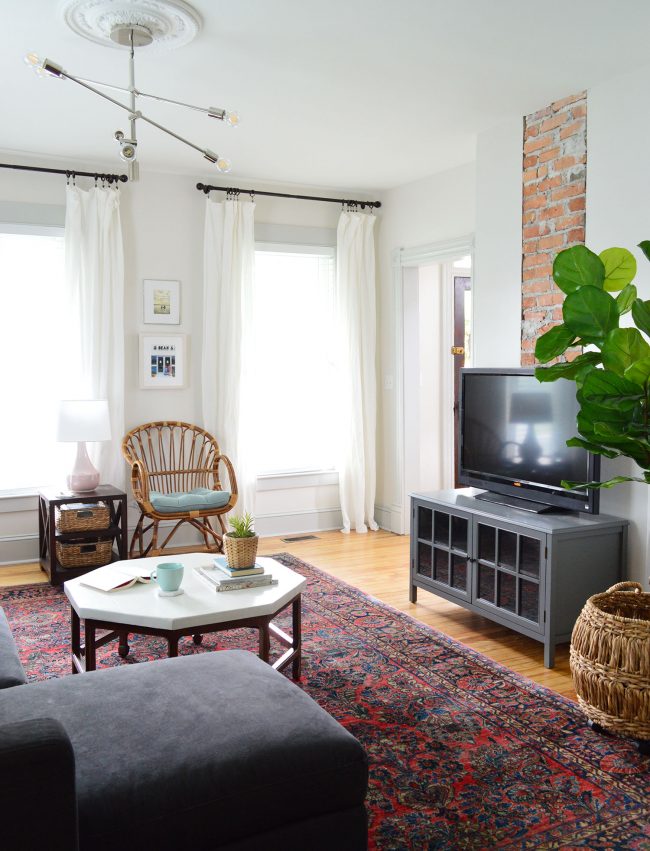
light / ceiling medallion / similar rug / similar curtains / curtain rods / TV stand / similar chair
The white top breaks up the darker rug and couch nicely, and also helps tie together some of the other bright white accents like the bookshelf and the curtains.

It’s hard to tell from these photos, but although the concrete is super glossy and chunky, it still has imperfections, which is definitely part of the charm. Instead of looking like a big block of shiny plastic, it gives off that raw concrete vibe – even in the glossy white color. This next picture probably best shows a few light trowel marks. It all feels smooth to the touch, but when you look closely they’re definitely there. Again, this is some of the “interest” that we expected from the Ardex process (or at least my version of it – ha!) and for us it takes the place of the movement we would’ve gotten from a stone like marble.
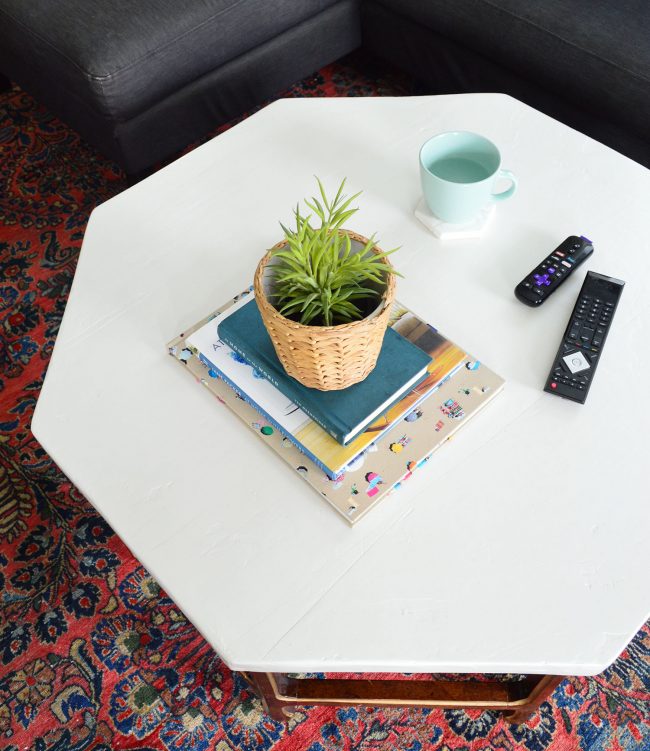
Sherry and I have also discussed everything from staining the wood base a little bit darker (especially to disguise the light edges) to painting the while base a glossy white to emphasize the interesting shape of the legs. But for now I’ve argued that we should just kick up our feet and enjoy having a place to actually kick up our feet. IS THAT TOO MUCH TO ASK?
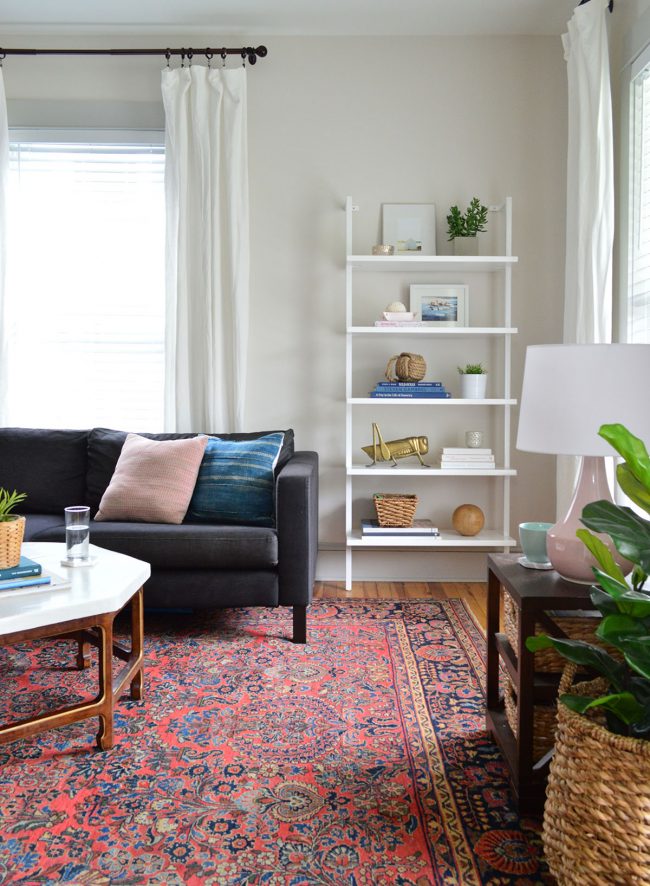
bookcase / similar pink pillow / similar blue pillow / white faux wood window blinds
And don’t even get me started on the other furniture adjustments we’re thinking about in this room. Actually since we took these photos we’ve painted and recovered two armchairs for that wall on the right, so there’s a lot more comfy seating in here now (although we’re thinking about a few other adjustments before calling it done). But that’s a topic for another day!
Also! If you have any where-did-you-get-that questions about the beach house (or paint color questions, which we also get a lot) this page has all the answers for you.
P.S. Do you get our free weekly emails? We love sending bonus details, design tips, random style thoughts, and other house-related stuff. Click here to get them delivered right to your inbox. And thanks to everyone who is on the list already – Sherry loves putting them together for you each week.
*This post contains affiliate links*
